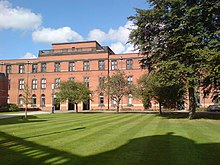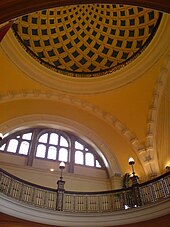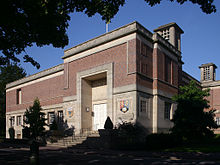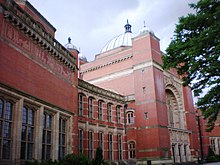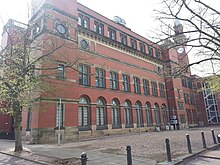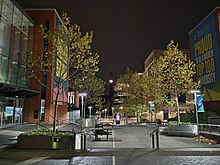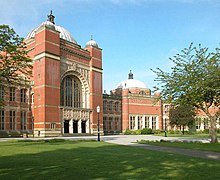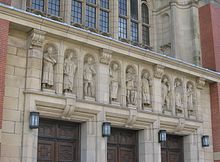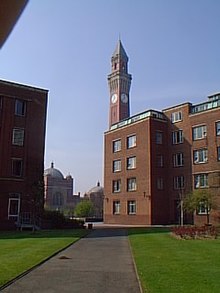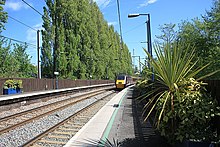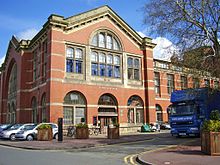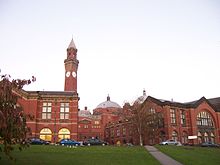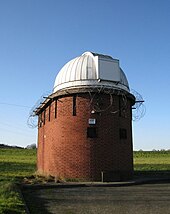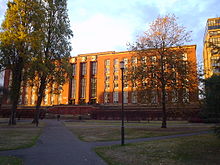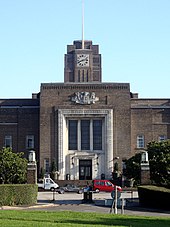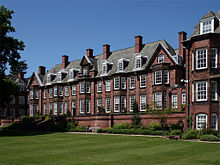A | B | C | D | E | F | G | H | CH | I | J | K | L | M | N | O | P | Q | R | S | T | U | V | W | X | Y | Z | 0 | 1 | 2 | 3 | 4 | 5 | 6 | 7 | 8 | 9
The University of Birmingham (informally Birmingham University)[8][9] is a public research university located in Edgbaston, Birmingham, United Kingdom. It received its royal charter in 1900 as a successor to Queen's College, Birmingham (founded in 1825 as the Birmingham School of Medicine and Surgery), and Mason Science College (established in 1875 by Sir Josiah Mason), making it the first English civic or 'red brick' university to receive its own royal charter.[2][10] It is a founding member of both the Russell Group of British research universities and the international network of research universities, Universitas 21.
The student population includes 23,155 undergraduate and 12,605 postgraduate students in 2019–20, which is the 7th largest in the UK (out of 169). The annual income of the university for 2021–22 was £869.8 million of which £215.0 million was from research grants and contracts, with an expenditure of £1.02 billion.[4] In the 2021 Research Excellence Framework, the University of Birmingham ranked equal 13th out of 129 institutions on grade point average, up from equal 31st in the previous REF in 2014.[11]
The university is home to the Barber Institute of Fine Arts, housing works by Van Gogh, Picasso and Monet; the Shakespeare Institute; the Cadbury Research Library, home to the Mingana Collection of Middle Eastern manuscripts; the Lapworth Museum of Geology; and the 100-metre Joseph Chamberlain Memorial Clock Tower, which is a prominent landmark visible from many parts of the city.[12] Academics and alumni of the university include former British Prime Ministers Neville Chamberlain and Stanley Baldwin,[13] the British composer Sir Edward Elgar and eleven Nobel laureates.[14]
History
Queen's College
The earliest beginnings of the university were originally traced back to the Queen's College, which is linked to William Sands Cox in his aim of creating a medical school along strictly Christian lines, unlike the contemporary London medical schools.[citation needed] Further research[by whom?] revealed the roots of the Birmingham Medical School in the medical education seminars of John Tomlinson, the first surgeon to the Birmingham Workhouse Infirmary, and later to the Birmingham General Hospital. These classes, held in the winter of 1767–68, were the first such lectures ever held in England or Wales. The first clinical teaching was undertaken by medical apprentices at the General Hospital, founded in 1779. The medical school which grew out of the Birmingham Workhouse Infirmary was founded in 1828, but Cox began teaching in December 1825. Queen Victoria granted her patronage to the Clinical Hospital in Birmingham and allowed it to be styled "The Queen's Hospital". It was the first provincial teaching hospital in England. In 1843, the medical college became known as Queen's College.[15]
Mason Science College
In 1870, Sir Josiah Mason, the Birmingham industrialist and philanthropist, who made his fortune in making key rings, pens, pen nibs and electroplating, drew up the Foundation Deed for Mason Science College.[3] The college was founded in 1875.[2] It was this institution that would eventually form the nucleus of the University of Birmingham. In 1882, the Departments of Chemistry, Botany and Physiology were transferred to Mason Science College, soon followed by the Departments of Physics and Comparative Anatomy. The transfer of the Medical School to Mason Science College gave considerable impetus to the growing importance of that college and in 1896 a move to incorporate it as a university college was made. As the result of the Mason University College Act 1897 it became incorporated as Mason University College on 1 January 1898, with Joseph Chamberlain becoming the President of its Court of Governors.
Royal charter
It was largely due to Chamberlain's enthusiasm that the university was granted a royal charter by Queen Victoria on 24 March 1900.[16] The Calthorpe family offered twenty-five acres (10 hectares) of land on the Bournbrook side of their estate in July. The Court of Governors received the Birmingham University Act 1900, which put the royal charter into effect on 31 May.
The transfer of Mason University College to the new University of Birmingham, with Chamberlain as its first chancellor and Sir Oliver Lodge as the first principal, was complete. A remnant of Josiah Mason's legacy is the Mermaid from his coat-of-arms, which appears in the sinister chief of the university shield and of his college, the double-headed lion in the dexter.[17]
The commerce faculty was founded by Sir William Ashley in 1901, who from 1902 until 1923 served as first Professor of Commerce and Dean of the Faculty. From 1905 to 1908, Edward Elgar held the position of Peyton Professor of Music at the university. He was succeeded by his friend Granville Bantock.[18]
The university's own heritage archives are accessible for research through the university's Cadbury Research Library which is open to all interested researchers.[19]
During the First World War, the Great Hall in the Aston Webb Building was requisitioned by the War Office to create the 1st Southern General Hospital, a facility for the Royal Army Medical Corps to treat military casualties; it was equipped with 520 beds and treated 125,000 injured servicemen.[20]
In June 1921, the university appointed Linetta de Castelvecchio as Serena Professor of Italian: she was the first woman to hold a chair at the university and one of the first women professors in Great Britain.[21][22]
Expansion
In 1939, the Barber Institute of Fine Arts, designed by Robert Atkinson, was opened. In 1956, the first MSc programme in Geotechnical Engineering commenced under the title of "Foundation Engineering", and has been run annually at the university since.
The UK's longest-running MSc programme in Physics and Technology of Nuclear Reactors also started at the university in 1956, the same year that the world's first commercial nuclear power station was opened at Calder Hall in Cumbria.
In 1957, Sir Hugh Casson and Neville Conder were asked by the university to prepare a masterplan on the site of the original 1900 buildings which were incomplete. The university drafted in other architects to amend the masterplan produced by the group. During the 1960s, the university constructed numerous large buildings, expanding the campus.[23] In 1963, the university helped in the establishment of the faculty of medicine at the University of Rhodesia, now the University of Zimbabwe (UZ). UZ is now independent but both institutions maintain relations through student exchange programmes.
Birmingham also supported the creation of Keele University (formerly University College of North Staffordshire) and the University of Warwick under the Vice-Chancellorship of Sir Robert Aitken who acted as 'godfather' to the University of Warwick.[24] The initial plan was to establish a satellite university college in Coventry but Aitken advised an independent initiative to the University Grants Committee.[25]
Malcolm X, the Afro-American human rights activist, addressed the University Debating Society in 1965.[20]
Scientific discoveries and inventions
The university has been involved in many scientific breakthroughs and inventions. From 1925 until 1948, Sir Norman Haworth was Professor and Director of the Department of Chemistry. He was appointed Dean of the Faculty of Science and acted as Vice-Principal from 1947 until 1948. His research focused predominantly on carbohydrate chemistry in which he confirmed a number of structures of optically active sugars. By 1928, he had deduced and confirmed the structures of maltose, cellobiose, lactose, gentiobiose, melibiose, gentianose, raffinose, as well as the glucoside ring tautomeric structure of aldose sugars. His research helped to define the basic features of the starch, cellulose, glycogen, inulin and xylan molecules. He also contributed towards solving the problems with bacterial polysaccharides. He was a recipient of the Nobel Prize in Chemistry in 1937.[26]
The cavity magnetron was developed in the Department of Physics by Sir John Randall, Harry Boot and James Sayers. This was vital to the Allied victory in World War II. In 1940, the Frisch–Peierls memorandum, a document which demonstrated that the atomic bomb was more than simply theoretically possible, was written in the Physics Department by Sir Rudolf Peierls and Otto Frisch. The university also hosted early work on gaseous diffusion in the Chemistry department when it was located in the Hills building.
Physicist Sir Mark Oliphant made a proposal for the construction of a proton-synchrotron in 1943, however he made no assertion that the machine would work. In 1945, phase stability was discovered; consequently, the proposal was revived, and construction of a machine that could surpass proton energies of 1 GeV began at the university. However, because of lack of funds, the machine did not start until 1953. The Brookhaven National Laboratory managed to beat them; they started their Cosmotron in 1952, and had it entirely working in 1953, before the University of Birmingham.[27]
In 1947, Sir Peter Medawar was appointed Mason Professor of Zoology at the university. His work involved investigating the phenomenon of tolerance and transplantation immunity. He collaborated with Rupert E. Billingham and they did research on problems of pigmentation and skin grafting in cattle. They used skin grafting to differentiate between monozygotic and dizygotic twins in cattle. Taking the earlier research of R. D. Owen into consideration, they concluded that actively acquired tolerance of homografts could be artificially reproduced. For this research, Medawar was elected a Fellow of the Royal Society. He left Birmingham in 1951 and joined the faculty at University College London, where he continued his research on transplantation immunity. He was a recipient of the Nobel Prize in Physiology or Medicine in 1960.[28]
Recent history
In 1999 talks commenced on the possibility of Aston University integrating itself into the University of Birmingham as the University of Birmingham, Aston Campus. This would have resulted in the University of Birmingham expanding to become one of the largest universities in the UK, with a student body of 30,000. Talks were halted in 2001 after Aston University determined the timing to be inopportune. While Aston University management was in favour of the integration, and reception among staff was generally positive, the Aston student union voted two-to-one against the integration. Despite this set back, the Vice Chancellor of the University of Birmingham said the door remained open to recommence talks when Aston University is ready.[29]
The final round of the first ever televised leaders' debates, hosted by the BBC, was held at the university during the 2010 British general election campaign on 29 April 2010.[30][31]
On 9 August 2010 the university announced that for the first time it would not enter the UCAS clearing process for 2010 admission, which matches under-subscribed courses to students who did not meet their firm or insurance choices, due to all places being taken. Largely a result of the financial crisis of 2007–2010, Birmingham joined fellow Russell Group universities including Oxford, Cambridge, Edinburgh and Bristol in not offering any clearing places.[32]
The university acted as a training camp for the Jamaican athletics team prior to the 2012 London Olympics.[33]
A new library was opened for the 2016/17 academic year, and a new sports centre opened in May 2017.[34] The previous Main Library and the old Munrow Sports Centre, including the athletics track, have both since been demolished, with the demolition of the old library being completed in November 2017.[35]
Controversies
This article's Criticism or Controversy section may compromise the article's neutrality by separating out potentially negative information. (May 2021) |
The discipline of cultural studies was founded at the university and between 1964 and 2002 the campus was home to the Centre for Contemporary Cultural Studies, a research centre whose members' work came to be known as the Birmingham School of Cultural Studies. Despite being established by one of the key figures in the field, Richard Hoggart, and being later directed by the theorist Stuart Hall, the department was controversially closed down.[36]
Analysis showed that the university was fourth in a list of British universities that faced the most employment tribunal claims between 2008 and 2011. They were the second most likely to settle these before the hearing date.[37]
In 2011 a parliamentary early day motion was proposed, arguing against the Guild suspending the elected Sabbatical Vice President (Education), who was arrested while taking part in protest activity.[38]
In December 2011 it was announced that the university had obtained a 12-month-long injunction[39] against a group of around 25 students, who occupied a residential building on campus from 23 to 26 November 2011, preventing them from engaging in further "occupational protest action" on the university's grounds without prior permission. It was misreported in the press that this injunction applied to all students, however the court order defines the defendants as:
Persons unknown (including students of the University of Birmingham) entering or remaining upon the buildings known as No. 2 Lodge Pritchatts Road, Birmingham at the University of Birmingham for the purpose of protest action (without the consent of the University of Birmingham).[40]
The university and the Guild of Students also clarified the scope of the injunction in an e-mail sent to all students on 11 January 2012, stating: "The injunction applies only to those individuals who occupied the lodge".[41] The university said that it sought this injunction as a safety precaution based on a previous occupation.[42] Three separate human rights groups, including Amnesty International, condemned the move as restrictive on human rights.[43]
In 2019, several women said the university refused to investigate allegations of campus rape. One student who complained of rape in university accommodation was told by employees of the university that there were no specific procedures for handling rape complaints. In other cases students were told they would have to prove the alleged rapes occurred on university property. The university has been criticized by legal professionals for not adequately assessing the risk to students by refusing to investigate complaints of criminal conduct.[44]
In June 2022 the University published a report into, and apologised for, its involvement in developing, promoting and administering electric-shock conversion therapy to gay men, during the period 1966-1983.[45][46]
Campuses
Edgbaston campus
Original buildings
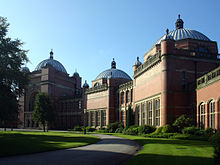
The main campus of the university occupies a site some 3 miles (4.8 km) south-west of Birmingham city centre, in Edgbaston. It is arranged around Joseph Chamberlain Memorial Clock Tower (affectionately known as 'Old Joe' or 'Big Joe'), a grand campanile which commemorates the university's first chancellor, Joseph Chamberlain.[47] Chamberlain may be considered the founder of Birmingham University, and was largely responsible for the university gaining its Royal Charter in 1900 and for the development of the Edgbaston campus. The university's Great Hall is located in the domed Aston Webb Building, which is named after one of the architects – the other was Ingress Bell. The initial 25-acre (100,000 m2) site was given to the university in 1900 by Lord Calthorpe. The grand buildings were an outcome of the £50,000 given by steel magnate and philanthropist Andrew Carnegie to establish a "first class modern scientific college"[48] on the model of Cornell University in the United States.[49] Funding was also provided by Sir Charles Holcroft.[50]
The original domed buildings, built in Accrington red brick, semicircle to form Chancellor's Court. This sits on a 30 feet (9.1 m) drop, so the architects placed their buildings on two tiers with a 16 feet (4.9 m) drop between them. The clock tower stands in the centre of the Court.
The campanile itself draws its inspiration from the Torre del Mangia, a medieval clock tower that forms part of the Town Hall in Siena, Italy.[51] When it was built, it was described as 'the intellectual beacon of the Midlands' by the Birmingham Post. The clock tower was Birmingham's tallest building from the date of its construction in 1908 until 1969; it is now the third highest in the city. It is one of the top 50 tallest buildings in the UK,[52] and the tallest free-standing clock tower in the world,[12] although there is some confusion about its actual height, with the university listing it both as 110 metres (361 ft)[53] and 325 feet (99 m) tall in different sources.[54]
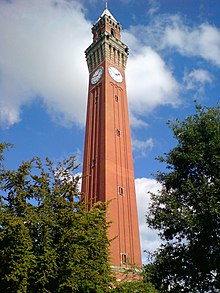
The campus has a wide diversity in architectural types and architects. "What makes Birmingham so exceptional among the Red Brick universities is the deployment of so many other major Modernist practices: only Oxford and Cambridge boast greater selections".[55] The Guild of Students original section was designed by Birmingham inter-war architect Holland Hobbiss who also designed the King Edward's School opposite. It was described as "Redbrick Tudorish" by Nikolaus Pevsner.[56]
The statue on horseback fronting the entrance to the university and Barber Institute of Fine Arts is a 1722 statue of George I rescued from Dublin in 1937. This was saved by Bodkin, a director of the National Gallery of Ireland and first director of the Barber Institute. The statue was commissioned by the Dublin Corporation from the Flemish sculptor John van Nost.[57]
Final negotiations for part of what is now the Vale were only completed in March 1947. By then, properties which would have their names used for halls of residences such as Wyddrington and Maple Bank were under discussion and more land was obtained from the Calthorpe estate in 1948 and 1949 providing the setting for the Vale.[58] Landscape architect Mary Mitchell designed the layout of the campus and she included mature trees that were retained from the former gardens.[59] Construction on the Vale started in 1962 with the creation of a 3-acre (12,000 m2) artificial lake and the building of Ridge, High, Wyddrington and Lake Halls. The first, Ridge Hall, opened for 139 women in January 1964, with its counterpart High Hall admitting its first male residents the following October.[60]
1960s and modern expansion
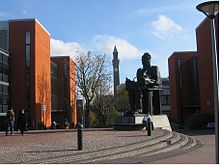
The university underwent a major expansion in the 1960s due to the production of a masterplan by Casson, Conder and Partners. The first of the major buildings to be constructed to a design by the firm was the Refectory and Staff House which was built in 1961 and 1962. The two buildings are connected by a bridge. The next major buildings to be constructed were the Wyddrington and Lake Halls and the Faculty of Commerce and Social Science, all completed in 1965. The Wyddrington and Lake Halls, on Edgbaston Park Road, were designed by H. T. Cadbury-Brown and contained three floors of student dwellings above a single floor of communal facilities.[citation needed]
The Faculty of Commerce and Social Science, now known as the Ashley Building, was designed by Howell, Killick, Partridge and Amis and is a long, curving two-storey block linked to a five-storey whorl. The two-storey block follows the curve of the road, and has load-bearing brick cross walls. It is faced in specially-made concrete blocks. The spiral is faced with faceted pre-cast concrete cladding panels.[23] It was statutorily listed in 1993[61] and a refurbishment by Berman Guedes Stretton was completed in 2006.[62]
Chamberlain, Powell and Bon were commissioned to design the Physical Education Centre which was built in 1966. The main characteristic of the building is the roof of the changing rooms and small gymnasium which has hyperbolic paraboloid roof light shells and is completely paved in quarry tiles. The roof of the sports hall consists of eight conoidal 2½-inch thick sprayed concrete shells springing from 80-foot (24 m) long pre-stressed valley beams. On the south elevation, the roof is supported on raking pre-cast columns and reversed shells form a cantilevered canopy.[citation needed]
Also completed in 1966 was the Mining and Minerals Engineering and Physical Metallurgy Departments, which was designed by Philip Dowson of Arup Associates. This complex consisted of four similar three-storey blocks linked at the corners. The frame is of pre-cast reinforced concrete with columns in groups of four and the whole is planned as a tartan grid, allowing services to be carried vertically and horizontally so that at no point in a room are services more than ten feet away. The building received the 1966 RIBA Architecture Award for the West Midlands.[23] It was statutorily listed in 1993.[61] Taking the full five years from 1962 to 1967, Birmingham erected twelve buildings which each cost in excess of a quarter of a million pounds.[63]
In 1967, Lucas House, a new hall of residence designed by The John Madin Design Group, was completed, providing 150 study bedrooms. It was constructed in the garden of a large house. The Medical School was extended in 1967 to a design by Leonard J. Multon and Partners. The two-storey building was part of a complex which covers the southside of Metchley Fort, a Roman fort. In 1968, the Institute for Education in the Department for Education was opened. This was another Casson, Conder and Partners-designed building. The complex consisted of a group of buildings centred around an eight-storey block, containing study offices, laboratories and teaching rooms. The building has a reinforced concrete frame which is exposed internally and the external walls are of silver-grey rustic bricks. The roofs of the lecture halls, penthouse and Child Study wing are covered in copper.[23]
Arup Associates returned in the 1960s to design the Arts and Commerce Building, better known as Muirhead Tower and houses the Institute of Local Government Studies. This was completed in 1969.[23] A£42 million refurbishment of the 16-storey tower was completed in 2009 and it now houses the Colleges of Social Sciences and the Cadbury Research Library, the new home for the university's Special Collections. The podium was remodeled around the existing Allardyce Nicol studio theatre, providing additional rehearsal spaces and changing and technical facilities. The ground floor lobby now incorporates a Starbucks coffee shop.[64] The name, Muirhead Tower, came from that of the first philosophy professor of the university John Henry Muirhead.[64][65][66]
Recently[when?] completed is a 450-seat concert hall, called the Bramall Music Building, which completes the redbrick semicircle of the Aston Webb building designed by Glenn Howells Architects with venue design by Acoustic Dimensions. This auditorium, with its associated research, teaching and rehearsal facilities, houses the Department of Music.[67] In August 2011 the university announced that architects Lifschutz Davidson Sandilands and S&P were appointed to develop a new Indoor Sports Centre as part of a £175 million investment in the campus.[needs update][68]
Other features
In 1978, University station, on the Cross-City Line, was opened to serve the university and its hospital. It is the only university campus in mainland Britain with its own railway station.[citation needed] As of 2022[update] a new station is being constructed, adjacent to the existing facility.[69] Nearby, the Steampipe Bridge, which was constructed in 2011, transports steam across the Cross-City Railway Line and Worcester & Birmingham Canal from the energy generation plant to the medical school as part of the university's sustainable energy strategy. Its laser-cut exterior is also a public art feature.[70]
Located within the Edgbaston site of the university is the Winterbourne Botanic Garden, a 24,000 square metre (258,000 square foot) Edwardian Arts and Crafts style garden. The large statue in the foreground was a gift to the university by its sculptor Sir Edward Paolozzi – the sculpture is named 'Faraday', and has an excerpt from the poem 'The Dry Salvages' by T. S. Eliot around its base.
The University of Birmingham operates the Lapworth Museum of Geology in the Aston Webb Building in Edgbaston. It is named after Charles Lapworth, a geologist who worked at Mason Science College.
Since November 2007, the university has been holding a farmers' market on the campus.[71] Birmingham is the first university in the country to have an accredited farmers' market.[72]
The considerable extent of the estate meant that by the end of the 1990s it was valued at £536 million.[73]
University of Birmingham marked its grand ending of Green Heart Project at the start of 2019.[74][75]
Selly Oak campus
The university's Selly Oak campus is a short distance to the south of the main campus. It was the home of a federation of nine colleges, known as Selly Oak Colleges, mainly focused on theology, social work, and teacher training.[76] The Federation was for many years associated with the University of Birmingham. A new library, the Orchard Learning Resource Centre, was opened in 2001, shortly before the Federation ceased to exist. The OLRC is now one of Birmingham University's site libraries.[77] Among the Selly Oak Colleges was Westhill College, (later the University of Birmingham, Westhill), which merged with the university's School of Education in 2001.[78] In the following years most of the remaining colleges closed, leaving two colleges which continue today, Woodbrooke College, a study and conference centre for the Society of Friends, and Fircroft College, a small adult education college with residential provision. Woodbrooke College's Centre for Postgraduate Quaker Studies, established in 1998, works with the University of Birmingham to deliver research supervision for the degrees of MA by research and PhD.[79]
The Selly Oak campus is now home to the Department of Drama and Theatre Arts in the newly refurbished Selly Oak Colleges Old Library and George Cadbury Hall 200-seat theatre.[80] The UK daytime television show Doctors is filmed on this campus.[81] The University of Birmingham School occupies a brand new, purpose-built building located on the university's Selly Oak campus.[82] The University of Birmingham School is sponsored by the University of Birmingham and managed by an Academy Trust. The University of Birmingham School opened in September 2015.[83]
Mason College and Queen's College campus

The Victorian neo-gothic Mason College Building in Birmingham city centre housed Birmingham University's Faculties of Arts and Law for over 50 years after the founding of the university in 1900. The Faculty of Arts building on the Edgbaston campus was not constructed until 1959–61. The Faculties of Arts and Law then moved to the Edgbaston campus.[84] The original Mason College Building was demolished in 1962 as part of the redevelopment within the inner ring road.
The 1843 Gothic Revival building constructed opposite the Town Hall between Paradise Street (the main entrance) and Swallow Street served as Queen's College, one of the founder colleges of the university. In 1904 the building was given a new buff-coloured terracotta and brick front. The medical and scientific departments merged with Mason College in 1900 to form the University of Birmingham and sought new premises in Edgbaston. The theological department of Queen's College did not merge with Mason College, but later moved in 1923 to Somerset Road in Edgbaston, next to the University of Birmingham as the Queen's Foundation, maintaining a relationship with the University of Birmingham until a 2010 review. In the mid 1970s, the original Queen's College building was demolished, with the exception of the grade II listed façade.
Organisation and administration
Academic departments
Birmingham has departments covering a wide range of subjects. On 1 August 2008, the university's system was restructured into five 'colleges', which are composed of numerous 'schools':
- Arts and Law (English, Drama and Creative Studies; History and Cultures; Languages, Cultures, Art History and Music; Birmingham Law School; Philosophy, Theology and Religion)
- Engineering and Physical Sciences (Chemistry; Chemical Engineering; Computer Science; Engineering (comprising the Departments of civil, Mechanical and Electrical, Electronic & Systems Engineering); Mathematics; Metallurgy and Materials; Physics and Astronomy)
- Life and Environmental Sciences (Biosciences; Geography, Earth and Environmental Sciences; Psychology; Sport and Exercise Sciences)
- Medical and Dental Sciences (Institute of Cancer and Genomic Sciences; Institute of Clinical Sciences; Institute of Inflammation and Ageing; Institute of Applied Health Research; Institute of Cardiovascular Science; Institute of Immunology and Immunotherapy; Institute of Metabolism and Systems Research; Institute of Microbiology and Infection).
- Social Sciences (Birmingham Business School; Education; Government and Society; Social Policy)
- Liberal Arts and Sciences
The university is home to a number of research centres and schools, including the Birmingham Business School, the oldest business school in England, the University of Birmingham Medical School, the International Development Department, the Institute of Local Government Studies, the Centre of West African Studies, the Centre for Russian and East European Studies, the Centre of Excellence for Research in Computational Intelligence and Applications and the Shakespeare Institute. An Institute for Research into Superdiversity was established in 2013.[85] Apart from traditional research and PhDs, under the department of Engineering and Physical Sciences, the university offers split-site PhD in Computer Science.[86] The university is also home to the Birmingham Solar Oscillations Network (BiSON) which consists of a network of six remote solar observatories monitoring low-degree solar oscillation modes. It is operated by the High Resolution Optical Spectroscopy group of the School of Physics and Astronomy, funded by the Science and Technology Facilities Council (STFC).[87]
International Development Department
The International Development Department (IDD) is a multi-disciplinary academic department focused on poverty reduction through developing effective governance systems. The department is one of the leading UK centres for the postgraduate study of international development.[88] The department has been described as being a "highly regarded, long-established specialist unit" with a "global reputation" by The Independent.[89]
Off-campus establishments

A number of the university's centres, schools and institutes are located away from its two campuses in Edgbaston and Selly Oak:
- The Shakespeare Institute, in Stratford-upon-Avon, which is a centre for postgraduate study dedicated to the study of William Shakespeare and the literature of the English Renaissance.
- The Ironbridge Institute, in Ironbridge, which offers postgraduate and professional development courses in heritage.
- The School of Dentistry (the UK's oldest dental school), in Birmingham City Centre.
- The Raymond Priestley Centre, near Coniston in the Lake District, which is used for outdoor pursuits and field work.[90]
There is also a Masonic Lodge that has been associated with the university since 1938.[91]
University of Birmingham Observatory
In the early 1980s, the University of Birmingham constructed an observatory next to the university playing fields, approximately 5 miles (8.0 km) south of the Edgbaston campus. The site was chosen because the night sky was ~100 times darker than the skies above campus. First light was on 8 December 1982, and the Observatory was officially opened by the Astronomer Royal, Francis Graham-Smith, on 13 June 1984.[92] The observatory was upgraded in 2013.
The Observatory is used primarily for undergraduate teaching.[93] It has two main instruments, a 16" Cassegrain (working at f/19) and a 14" Meade LX200R (working at f/6.35). A third telescope is also present and is used exclusively for visual observations.
Members of the public are given chance to visit the Observatory at regular Astronomy in the City events during the winter months.[94] These events include a talk on the night sky from a member of the university's student Astronomical Society; a talk on current astrophysics research, such as exoplanets, galaxy clusters or gravitational-wave astronomy,[95] a question-and-answer session, and the chance to observing using telescopes both on campus and at the Observatory.
Branding
The original coat of arms was designed in 1900. It features a double headed lion (on the left) and a mermaid holding a mirror and comb (to the right). These symbols owe to the coat of arms of the institution's predecessor, Mason College.
In 2005 the university began rebranding itself. A simplified edition of the shield which had been introduced in the 1980s reverted to a detailed version based on how it appears on the university's original Royal Charter.
Academic profile
Libraries and collections
Library Services operates six libraries. They are the Barber Fine Art Library, Barnes Library, Main Library, Orchard Learning Resource Centre, Dental Library, and the Shakespeare Institute Library. Library Services also operates the Cadbury Research Library.[96]
The Shakespeare Institute's library is a major United Kingdom resource for the study of English Renaissance literature.[97]
The Cadbury Research Library is home to the University of Birmingham's historic collections of rare books, manuscripts, archives, photographs and associated artefacts. The collections, which have been built up over a period of 120 years consist of over 200,000 rare printed books including significant incunabula, as well as over 4 million unique archive and manuscript collections.[98] The Cadbury Research Library is responsible for directly supporting the university's research, learning and teaching agenda, along with supporting the national and international research community.
The Cadbury Research Library contains the Chamberlain collection of papers from Neville Chamberlain, Joseph Chamberlain and Austen Chamberlain, the Avon Papers belonging to Anthony Eden with material on the Suez Crisis, the Cadbury Papers relating to the Cadbury firm from 1900 to 1960, the Mingana Collection of Middle Eastern Manuscripts of Alphonse Mingana, the Noël Coward Collection, the papers of Edward Elgar, Oswald Mosley, and David Lodge, and the records of the English YMCA and of the Church Missionary Society. The Cadbury Research Library has recently taken in the complete archive of UK Save the Children. The Library holds important first editions such as De Humani Corporis (1543) by Versalius, the Complete Works (1616) of Ben Jonson, two copies of The Temple of Flora (1799-1807) by Robert Thornton and comprehensive collections of the works of Joseph Priestley and D H Lawrence as well as many other significant works.
In 2015, a Quranic manuscript in the Mingana Collection was identified as one of the oldest to have survived, having been written between 568 and 645.[99][100]
At the beginning of the 2016/17 academic year, a new main library opened on the Edgbaston campus and the old library has now been demolished as part of the plans to create a 'Green Heart' as per the original plans for the university whereby the clock tower would be visible from the North Gate.[101][102] The Harding Law Library was closed and renovated to become the university's Translation and Interpreting Suite.
Medicine
The University of Birmingham's medical school is one of the largest in Europe with well over 450 medical students being trained in each of the clinical years and over 1,000 teaching, research, technical and administrative staff[citation needed]. The school has centres of excellence in cancer, pharmacy, immunology, cardiovascular disease, neuroscience and endocrinology and renowned nationally and internationally for its research and developments in these fields.[103][better source needed] The medical school has close links with the NHS and works closely with 15 teaching hospitals and 50 primary care training practices in the West Midlands.
The University Hospital Birmingham NHS Foundation Trust is the main teaching hospital in the West Midlands. It has been given three stars for the past four consecutive years.[104] The trust also hosts the Royal Centre for Defence Medicine, based at Selly Oak Hospital, which provides medical support to military personnel such as military returned from fighting in the Iraq War.[105]
Rankings and reputationedit
| National rankings | |
|---|---|
| Complete (2023)[106] | 14 |
| Guardian (2023)[107] | 27 |
| Times / Sunday Times (2023)[108] | 20= |
| Global rankings | |
| ARWU (2022)[109] | 101–150 |
| QS (2023)[110] | 91 |
| THE (2023)[111] | 108= |
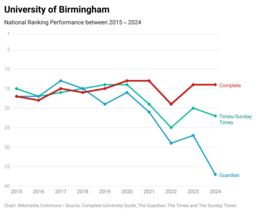
The 2022 U.S. News & World Report ranks Birmingham 91st in the world.[112] In 2019, it is ranked 137th among the universities around the world by SCImago Institutions Rankings.[113]
In 2021 the Times Higher Education placed Birmingham 12th in the UK.[114]
In 2013, Birmingham was named 'Sunday Times University of the Year 2014'.[115] The 2013 QS World University Rankings placed Birmingham University at 10th in the UK and 62nd internationally. Birmingham was ranked 12th in the UK in the 2008 Research Assessment Exercise with 16 percent of the university's research regarded as world-leading and 41 percent as internationally excellent, with particular strengths in the fields of music, physics, biosciences, computer science, mechanical engineering, political science, international relations and law.[116][117][118] Course satisfaction was at 85% in 2011 which grew to 88% in 2012.[119]
In 2015 the Complete University Guide placed Birmingham 5th in the UK for graduate prospects.[120]
Data from the Higher Education Funding Council for England (HEFCE) placed the university amongst the twelve elite institutions who among them take more than half of the students with the highest A-level grades.[121]
Birmingham traditionally had a focus on science, engineering, commerce and coal mining, but has now expanded its provision. It hosted the first Cancer Research UK Centre,[122] and making notable contributions to gravitational-wave astronomy, hosting the Institute of Gravitational Wave Astronomy.[123]
The School of Computer Science ranked 1st in the 2014 Guardian University Guide,[124] 4th in the 2013 Sunday Times League Table and 6th in the 2014 Sunday Times League Table.[125]
The Department of Philosophy ranked 3rd in the 2017 Guardian University League Tables,[126] below the University of Oxford and above the University of Cambridge, with the first being the University of St Andrews.
The combined course of Computer Science and Information Systems, titled Computer Systems Engineering was ranked 4th in the 2016 Guardian University guide.[127]
The Department of Political Science and International Studies (POLSIS) ranked 4th in the UK and 22nd in the world in the Hix rankings of political science departments.[128] The sociology department also ranked 4th by The Guardian University guide. The Research Fortnight's University Power Ranking, based on quality and quantity of research activity, put the University of Birmingham 12th in the UK, leading the way across a broad range of disciplines including Primary Care, Cancer Studies, Psychology and Sport and Exercise Sciences.[129] The School of Physics and Astronomy also performed well in the rankings, being ranked 3rd in the 2012 Guardian University Guide[130] and 7th in The Complete University Guide 2012.[131] The School of Chemical Engineering is ranked second in the UK by the 2014 Guardian University Guide.[132]
Admissionsedit
|
| Domicile[136] and Ethnicity[137] | Total | ||
|---|---|---|---|
| British White | 48% | ||
| British Ethnic Minorities[a] | 27% | ||
| International EU | 3% | ||
| International Non-EU | 22% | ||
| Undergraduate Widening Participation Indicators[138][139] | |||
| Female | 57% | ||
| Private School | 16% | ||
| Low Participation Areas[b] | 8% | ||
In terms of average UCAS points of entrants, Birmingham ranked 25th in Britain in 2014.[140] According to the 2017 Times and Sunday Times Good University Guide, approximately 20% of Birmingham's undergraduates come from independent schools.[141]
The university gives offers of admission to 79.2% of its applicants, the 8th highest amongst the Russell Group.[142] In the 2016–17 academic year, the university had a domicile breakdown of 76:5:18 of UK:EU:non-EU students respectively with a female to male ratio of 56:44.[143]
Birmingham Heroesedit
To highlight leading areas of research, the university has launched the Birmingham Heroes scheme. Academics who lead research that impacts on the lives of people regionally, nationally and globally can be nominated for selection.[144] Heroes include:
- Alberto Vecchio and Andreas Freise for their work as part of the LIGO Scientific Collaboration towards the first observation of gravitational waves[145]
- Martin Freer, Toby Peters and Yulong Ding for their work on energy efficient cooling[146]
- Philip Newsome, Thomas Solomon and Patricia Lalor for tackling the silent killers, liver disease and diabetes[147]
- James Arthur, Kristján Kristjánsson, Sandra Cooke and Tom Harrison for promoting character in education[148]
- Lisa Bortolotti, Ema Sullivan-Bissett and Michael Larkin for their work on how to break down the stigma associated with mental illness[149] Zdroj:https://en.wikipedia.org?pojem=University_of_Birmingham
>Text je dostupný pod licencí Creative Commons Uveďte autora – Zachovejte licenci, případně za dalších podmínek. Podrobnosti naleznete na stránce Podmínky užití.
Text je dostupný za podmienok Creative
Commons Attribution/Share-Alike License 3.0 Unported; prípadne za ďalších
podmienok.
Podrobnejšie informácie nájdete na stránke Podmienky
použitia.


